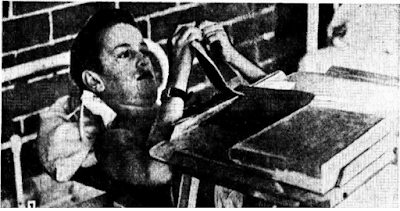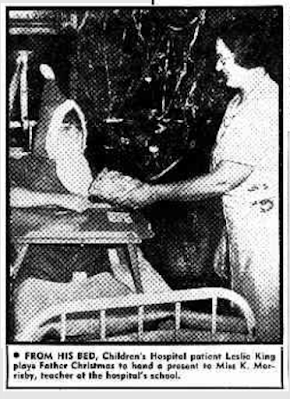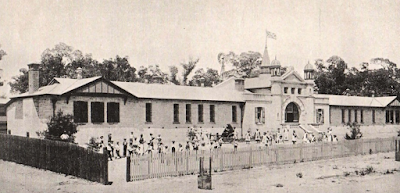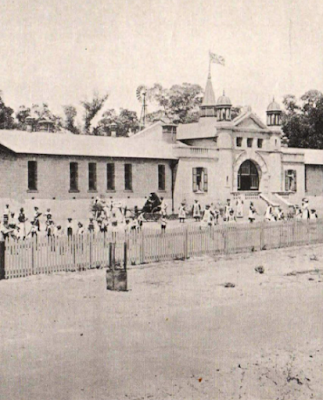Extraordinary Children...Children's Hospital in Subiaco (1944-1946).
This is the story of some of these children receiving treatment taught by Kathleen Morrisby from 1944 to 1946 at the school in the Children's Hospital in Subiaco.
Of particular interest was the teaching methods adopted by Kathleen in that all lessons were individually prepared for each child, a philosophy in education encouraged for all children today.
Although all the stories of the children and their willingness to achieve despite their illness are extraordinary, the story of Leslie King is particularly inspiring. Leslie King despite spending several years on his back took his junior examination in 1946.
The articles and photographs are from Trove, the database at the National Library of Australia. No copyright infringement intended.
Daily News, 13 December 1944.
CHILDREN GIVE CONCERT ON THEIR BACKS
Lying on their backs in hospital beds where they have been for many months, 25 children gave a concert at their first annual prize giving day held at the Children's Hospital, Subiaco, yesterday.
Because they could not act in a play that entailed walking about, a 13-year-old patient in the orthopaedic ward wrote a play in which they could all take part. Children were all dressed for their parts in costumes, they made themselves. The play was based on talking and actions with their hands. Although it was their break-up, and prize-giving day, the school will not commence summer holidays until the middle of January.
Prizes were awarded to 35 children, individually presented by Minister for Education Tonkin who walked to 25 beds, shook hands with the bedridden students. The other ten were discharged patients who had come along for their prizes.
School was established in February last, is taught by Miss Kathleen Morrisby of the Education Department, is held in five wards. Patients are all children on their backs. When the proceedings opened yesterday, Mr Tonkin, Director of Education M. Little, matron, nurses and others were welcomed by a speech from a 10-year-old boy. Chairman for the day was 13 year old Leslie King who wrote the play, has been on his back in the hospital for 15 months.
Children had made a present for every visitor and decorated a Christmas tree. The handing of presents from the tree was the climax of the day, was heralded by a hush of excitement from the children, surprise and pleasure from the guests. During interval, guests inspected the children's work, expressed, admiration for it. A duck made by Kathleen, a 13 year old girl, was especially admired. It compared more than favourably with similar work by adults.
When the school takes its holidays in January their teacher, Miss K. Morrisby, will at her own expense visit Melbourne Children's Hospital, Frankstown Orthopedic Hospital and probably one in Tasmania, will study methods of this special type of teaching.
Western Mail, 25 January 1945.
These Pupils Love Their Lessons.
THE other day I found a school where all the pupils love their lessons. Even though it is officially holiday time they still wanted to go to school. And even the little ones not yet old enough for regular lessons ask: "Please may we have school today?"
Odd, you may think. But it's not so odd when you go to see them and know all the circumstances as I did the other day. It was at the Children's Hospital that I found all these enthusiastic pupils, and they are ali children undergoing: treatment in the or-thopaedic ward. Here you see children of all ages recovering from infantile paralysis, or tubercular joints or maybe malformations which have twisted their limbs, and which without treatment would mean they could not walk properly.
The very nature of these complaints means that sometimes treatment must be continued for several years before a cure is effected. And sometimes it is not possible to cure a sick limb completely, but it can be made a great deal better.
So if these children did not 'go to school' while they are in hospital they would be backward with their lessons when the time came to resume their normal education.
Birth of an Idea.
A LITTLE more than a year ago Miss Kathleen Morrisby, a teacher attached to the Education Department, had an idea that by holding a school in the ward this disability would be overcome and the patients would be enabled later to take their place in the school room on an equal footing with other pupils.
Miss Morrisby approached the department with her idea and discussed the possibilities of starting a school there. This met with the department's sanction, and the Children's Hospital Board was approached for its approval. This was readily forthcoming and a year ago Miss Morrisby began her new work.
"I love it," she said enthusiastically the other day. "It is such a worthwhile work, and the young patients are keen to learn. And the Children's Hospital is a marvellous place to work in. There is splendid co-operation here."
And if you could see these young patients leave off their modelling or their algebra when a nurse came to give them an injection you would realise too just what a worthwhile work it is. For these children have courage. Hour after hour some of them have to lie on their backs strapped to a frame so that a limb may be immobilised, and all their schoolwork has to be done from that position.
Perhaps it is that they are so hopeful of leading a normal life when their sick limbs are cured that they are so anxious to learn history and geography and arithmetic now. For there is no doubt they are good pupils, and their exercise books would make any teacher feel proud of her charges.
Leslie King, for instance, is now in the subjunior class. He has been a patient for 15 months, and is now making good progress. His favourite subjects are arithmetic and English with algebra not very far behind. And Leslie's exercise book is a treat to see. Neat and tidy, there are very few corrections to be found here.
When he is not doing lessons, Leslie occupies his time making felt toys, and other kinds of needlework which can he done when you have to lie on your back. He has made Donald Duck, a doll, sprays of flowers, and crochet doy leys.
Patient from Moore River.
Further up the ward we found Carlon whose age is about 12 years. This young blackfellow had been sent down from the Moore River Settlement for treatment to a deformed foot, and he was kept fully occupied rolling and unrolling a piece of bright yellow plasticine and drawing "birds" on a slate with a piece of chalk.
Carlon could say "look" easily, and did so on every possible occasion pointing to imagined objects as he did so. But he was very happy as he sat in his cot, and soon had plenty of smiles when he became used to us.
Then there was Terry Anthony who has already spent two Christmases in hospital. She is fondest of cutting out pictures and sticking them in books. Shirley Cook, a patient for the last six months likes writing and drawing best. Stella Brand celebrated her sixth birthday last week and she loves sewing, drawing and cutting out.
Sue Lavater, Maurice Lilley, John Henderson and Coral Emery were others who all agreed that this was a wonderful school, and the days went quickly since Miss Morrisby came to teach them.
One of the highlights of their day was story time, when all the cots and beds are pushed up close together, and the children listen with close attention while Miss Morrisby reads them a story. This is good fun in which all can share.
A Christmas Play.
And would you believe it that 20 of these children produced a play called "Christmas Toys" and had a break-up party just before Christmas. They made their own costumes out of crepe paper, and made and stitched the programmes. Each patient said a poem and they each had a part in the play. Then they sang Christmas carols, and entertained doctors and visitors to tea. There were presents and prizes too, which were presented by the Minister for Education (Mr Tonkin). Although it was lots of fun.
Outlining an average day, Miss Morrisby said that the children must be taught individually because of their varying ages. When a patient is six he is started off with drawing and plasticine work if well enough and elementary school work. Those old enough take the ordinary school exams. Miss Morrisby has been with the Education Department for 10 years so has had lots of experience.
It is unfortunate that children patients in the orthopedic ward must leave when they are 13, and then if they still require further treatment must go either to the Perth Hospital or to their homes which illustrates once again how urgently is needed an orthopedic hospital for cases such as these.
In the meantime and for as long as they have to stay, there is no doubt at all that these young pupil-patients are happy at the Children's Hospital. And it is clearly demonstrated that a person does not feel an affliction so much if he is with others placed in a similar predicament as himself. The fact that they will not be backward with their schoolwork will make a tremendous difference to all of them later on.
Leslie King started another felt purse. Lying on his back he does all his school work and also makes toys and bags.
Carlon is not always as serious as this. His favourite pastime is rolling plasticine and drawing "birds" on his slate.
Cutting out pictures and making scrap books is the occupation best liked by young Terry Anthony who has already had two Christmases in hospital.

School work con be fun if you go the right way about it. Engrossed in her work, this young patient finds the time goes quickly.
Story time. Perhaps the hour looked forward to with greatest keenness by everyone. Miss Kathleen Morrisby is reading a story, and for this important event all the cots are pushed together so that all may hear.
Two more dark babies who found their stay in hospital a great adventure.
Saturday 15 December 1945.
WOMAN'S REALM. CHILDREN'S HOSPITAL.
Pupils' Break-up Day.
This is the season for school break-ups and an exciting time for all young people. Yesterday was a red-letter day for the small pupils of Ward 2 at the Children's Hospital.
For the past two or three months under the guidance of their teacher, Miss Kathleen Morrisby, these youngsters, many of whom have been in the hospital for upwards of two years; have worked hard to make their break-up an outstanding success; and so it turned out to be.
Some time ago invitations were sent to the superintendent, the manager, members of the hospital board, the matron, staff and parents to come along. Yesterday the guests sat on the lawn outside the ward while the children presented a programme of short plays and carols in which the adults were asked to join.
First came a most important event, the prize-giving. Among those who were there to receive their prizes were a few former patients now in good health as a result of the treatment that they had received at the hospital.
The programme opened with the Mad Hatter's Tea-party scene from "Alice in Wonderland." and concluded with a dramatic version of "The Sleeping Beauty." Although the majority of the youthful actors and actresses spend their days on their backs and played their parts from their cots, they showed few traces of shyness.
At the conclusion of the programme the King, of "The Sleeping Beauty" cast (whose beard had grown to venerable proportions during the 100 years' sleep imposed on the royal family by the wicked fairy), was transformed into Father Christmas, who, with the assistance of Miss Morrisby and members of the staff, distributed the gifts that hung on a Christmas tree. These had been made by the children.
There was something for everyone and, finally, a surprise packet in the form of a special gift from the children to Miss Morrisby to whose work the manager (Mr C. P. R. Austin) paid a tribute.
Daily News, 21 September 1946.
A coach is needed for Children's Hospital patient, Leslie King, who will take his Junior certificate examinations in November after having been on his back for more than three years.
He needs someone who will coach him in history and geography. Despite his years in hospital, Leslie is a keen student. Because world events have moved faster than can be recorded in school text books, he needs an outside viewpoint on history. Education Department teacher at the Children's Hospital, Subiaco, Miss Kathleen Morrisby, said today that Leslie could be coached either during the day or at night.
Leslie has been lying in a frame, with his legs in splints, in the orthopedic ward at the hospital for three years, has recovered sufficiently to allow a forecast that he may leave the hospital at the end of the year. He wants to become an accountant.
Daily News, 18 December 1946.
A boy who has been in hospital for more than three years played Father Christmas from his bed at the Children's Hospital, Subiaco, yesterday. In a red jacket and with flowing white beard, Leslie King handed out Christmas presents to guests and parents at the' hospital's school prize giving and Christmas play.
On the verandah of Ward 2 children lay in their beds, yet they were dressed for their parts, and were able to present an attractive programme. Education Minister Tonkin, Education Director Murray Little, and members of the Hospital Board and the medical profession were among the audience.
A Christmas tree and bowls of flowers added to the party atmosphere. Presents made by the children were ceremoniously given to relations and to the people who had so long cared tor them. Mr. Tonkin went to the bed of each patient to present the prizes. He praised the work of their teacher, Miss Kathleen Morrisby, and the co-operation given by the hospital management and staff-. 'When you leave this hospital and again take your place in the outside world, you will not be handicapped because of lack of education,' Mr. Tonkin told the children.
The school's greatest pride is Leslie King, who two weeks ago took six subjects for his junior examination while in bed.















